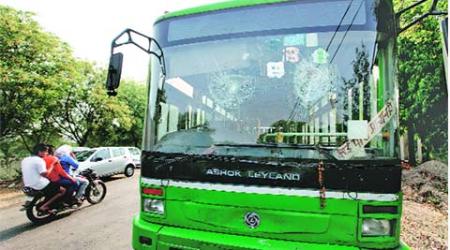 Many BEST enthusiasts rushed to Ravindranatya Mandir in Dadar on Sunday to catch glimpses of the relics of the past of the undertaking. (Express photo by Santosh Parab)
Many BEST enthusiasts rushed to Ravindranatya Mandir in Dadar on Sunday to catch glimpses of the relics of the past of the undertaking. (Express photo by Santosh Parab)
On a Tuesday evening, two men in light blue uniforms were making space for commuters waiting for buses on an already congested footpath at the bus stop near Churchgate railway station. For about an hour, their presence ensured kaali-peeli taxis remained 10-15 feet away from the bus stop. Within minutes, a bus arrived and waited longer than usual to pick up as many commuters as possible. The men in uniform were ticket collectors, who have been tasked with increasing the falling ridership of BEST buses, otherwise lost to kaali-peelis, which cash in on share rides offered on short distance routes. With losses amounting to over Rs 2,500 crore, the beleaguered public transport utility, which completes 70 years of becoming an undertaking on Monday, struggles to regain its past glory.
“In 1947, Bombay Electric Supply & Tramways Company became Bombay Electric Supply and Transport. The assets of the combined undertaking, namely the operation of tramways and distribution of electricity in the city, were handed over to them. By mutual agreement, the corporation also took charge of the operation of bus services, which was run by the Bombay Electric Supply and Tramway Company,” said Yatin Pimpale, curator of the Anik BEST depot museum.
Commuters and transport experts recall the days when the service was considered the best public transport across cities in India. With good connectivity and punctual services, queues at bus stops and packed buses were a common sight. “We do not remember waiting for more than 10 or 15 minutes to avail a bus back then. In fact, so loyal were we to meet our fixed timings to catch the bus that we had to reach the stop some time in advance. The buses would also be full,” said B B Shetty, a BEST commuter for 30 years, recalling the time between 1970 and 1980. Over the years, the loyal ridership of buses fell by at least 10 lakh. Senior officials blame it on poor decisions and mismanagement of the undertaking. Among them, increase in establishment cost without any match to the income generated by the department, deterioration in the quality of buses and increasing debt are cited to be the reasons.
“The undertaking failed to increase bus services in the last few years. The last bunch of 150 buses replaced the past lot, which were old and had to be scrapped. The utility has failed to innovate to attract new commuters and loyal commuters have found other means to commute. Failure to invest time and dedication to improve services led to its downfall,” said a former general manager of the undertaking.
The downfall aggravated after the Electricity Act 2003 disallowed BEST to use profits from the supply department for its transport wing. Hiring low-quality AC buses with shoddy public information system further lowered the image of the undertaking for commuters, transport experts said.
For its transport wing, BEST earns Rs 3.50 crore everyday but loses out to daily average expenditure of Rs 6 crore. Officials now fear losing out on high-end consumers of the supply division due to lower rates offered by competitors.
“The BMC is not helping us the way it should. Ignorance on its part towards our issues and no clarity on the undertaking’s part to address the crisis led to the downfall. While trying to take care of everybody’s interest, BEST suffers because of its failure to implement new decisions,” said Ravi Raja, Congress leader and committee member.
Merging the budget of BEST with BMC’ has remained another important demand of the undertaking. As of now, the utility stands to repay Rs 600 crore from a Rs 1,600-crore loan taken earlier from the corporation. While pleas were made to forfeit the remaining amount, no response was received. “The corporation eyes privatising the undertaking. Buying buses on contract lease, downsizing staff are decisions which are not healthy for the employees of the undertaking. Delayed disbursement of salaries takes a toll on each one of us. The corporation must pay heed to our concerns,” said Shashank Rao, leader of BEST Sanyukt Kamgar Kruti Samiti, the largest union.
“The undertaking failed to provide what was needed to be done. If the BMC plans to retain BEST, then due attention, which includes making a unified budget for the utility, must be included. As the supply wing is self-sufficient, the same could be kept out. However, if autonomy is sought for a utility that offers subsidised services to people, then it must be devoid of any kind of intervention,” said transport expert A V Shenoy.
“We have put in the best efforts to revive the undertaking. We seek the corporation’s financial help to fuel the working of this organisation for which we are taking steps as guided,” said Anil Kokil, Chairperson, BEST.
BEST runs 3,711 buses on 480 routes in the city.







